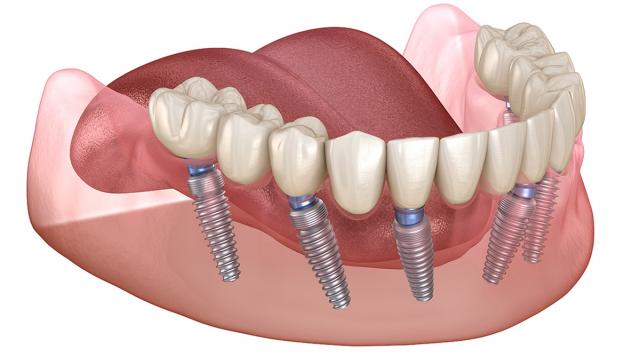29.07.2020.
Author: dr.med.dent.
All-on-6 procedure in Croatia
The All on 6 is a surgical method of placing 6 dental implants in a patient’s upper or lower jaw to which a fixed prosthetic work is fixed.

. By choosing this method of dental implant placement, the patient has the guarantee that he/she has chosen the most complete and highest-quality solution to compensate for missing teeth. Unlike the All on 4 method, the All on 6 method involves the placement of implants in the posterior regions of the jaw where there is often bone deficiency. When bone deficiency is experienced, it is necessary for the oral surgeon to know a number of techniques, which can compensate for the volume of the missing bone in a simpler or more complex way. Above all, it is necessary to make it clear to the patient what bone volume deficiencies we face in this region. It is important to determine the amount of remaining bone from the alveolar ridge to the bottom of the maxillary sinus in the upper jaw, or the remaining amount of bone from the alveolar ridge to the mandibular nerve in the lower jaw.
Upper jaw:
- with 8 or more millimetres of bone to the bottom of the maxillary sinus we have a favourable situation where we can easily approach the implant placement
- with 6-8 mm, it is possible to compensate for the missing bone volume with an internal sinus lift, by which we push the bottom of the maxillary sinus by 2-3 mm as it is needed for implant placement. This method is minimally invasive for the patient.
Lower jaw:
- the former limit of bone height above the mandibular nerve has been significantly changed since a number of implant companies today offer ultra-short implants that, with their strength and durability, function in the same way as longer dental implants, which means that a minimum bone surface of 6 mm is enough for dental implant placement in the posterior region of the lower jaw.
1st visit
During the first visit to the clinic, the patient undergoes a 3D X-ray to analyse the amount of bone and plan the procedure itself, as well as a clinical examination. A CT x-ray shows us the real state of the bone and allows us to know in advance what bone volume we expect in a particular area. Based on the performed diagnostic methods, the therapy plan is explained to the patient so he/she is informed about all oral surgical procedures that need to be performed for the purpose of implant placement. In a situation where the amount of bone allows us to install 6 dental implants, in the first procedure we remove the remaining teeth if the patient still has them and start with the placement of 6 dental implants. If the amount of bone is less than 8 mm to the bottom of the maxillary sinus, a minor sinus lift is performed in the posterior region of the upper jaw which is carried out in a few minutes and is completely non-invasive and painless for the patient. After placement of the dental implants, we take an impression on the placed implants, and on the same day fix the patient's temporary teeth. The complete procedure lasts 2 hours.
The advantage of this method of work is that the patient undergoes all invasive procedures in one sitting, and in subsequent visits there is no need for antibiotics or anaesthesia.
2nd visit
The second visit takes place 3-6 months from the first, and depends on the quality of the bone on the day of implant placement. During the second visit, the patient has his/her temporary teeth removed and an impression for final work is taken. It is necessary to define the colour, length, shape of the teeth, as well as the ratio of the teeth to the gums and the smile line with the dental technician. It is also indispensable to define the state of the face-bow, a device that serves us to determine the vertical and horizontal line of the finished work. This preparation enables the dental technician to determine with perfect precision the central part of the future definitive work according to the central part of the patient's face, and also that the horizontal line follows the patient's pupillary axis. The visit itself lasts 1 h.
3rd visit
The third visit is called an aesthetic testing. At this aesthetic testing, the patient has an impression of the definitive work for the first time as the teeth for the aesthetic testing made of acrylate are now fixed into the mouth.
Aesthetic testing is the most important element in achieving the high aesthetics and quality of the definitive work, because it serves the dental technician and dentist to check all previously determined rules. The patient becomes acquainted with the definitive work for the first time, and further corrections and changes in the work are possible at this point, in order to satisfy the patient's wishes and expectations in the definitive work. The visit itself is over within 1 hour.
4th visit
The fourth visit and also the last visit is where the patient's final work is fixed. The final work is fixed with screws to the implants, and the holes required for fixation are closed with a composite material. If the patient adheres to all the instructions received, this fixed prosthetic work will last a lifetime.
The patient should come for a check-up once a year. During examination, the work is removed, cleaned and disinfected using a special device if necessary, and then fixed in the patient's mouth again.
